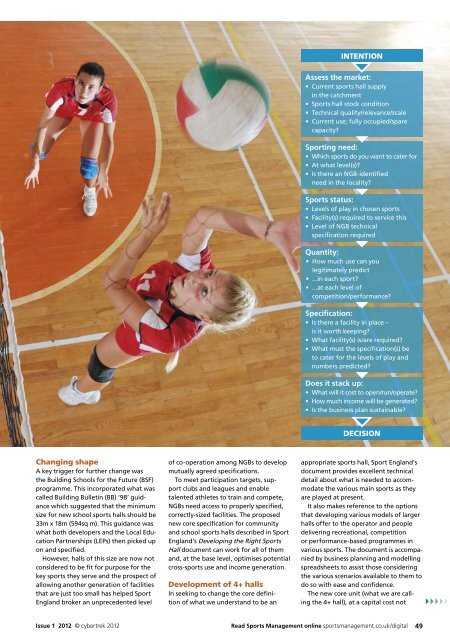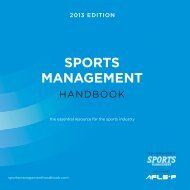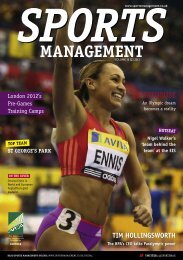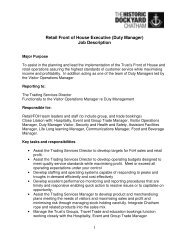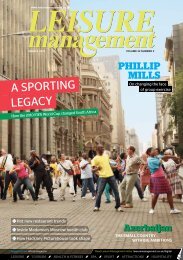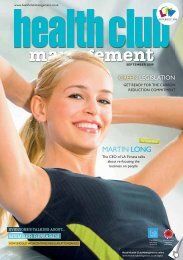Sports Management Issue 1 2012 - Leisure Opportunities
Sports Management Issue 1 2012 - Leisure Opportunities
Sports Management Issue 1 2012 - Leisure Opportunities
Create successful ePaper yourself
Turn your PDF publications into a flip-book with our unique Google optimized e-Paper software.
INTENTION<br />
Assess the market:<br />
Current sports hall supply<br />
in the catchment<br />
<strong>Sports</strong> hall stock condition<br />
Technical quality/relevance/scale<br />
Current use; fully occupied/spare<br />
capacity<br />
Sporting need:<br />
Which sports do you want to cater for<br />
At what level(s)<br />
Is there an NGB-identified<br />
need in the locality<br />
<strong>Sports</strong> status:<br />
Levels of play in chosen sports<br />
Facility(s) required to service this<br />
Level of NGB technical<br />
specification required<br />
Quantity:<br />
How much use can you<br />
legitimately predict<br />
...in each sport<br />
...at each level of<br />
competition/performance<br />
Specification:<br />
Is there a facility in place –<br />
is it worth keeping<br />
What facility(s) is/are required<br />
What must the specification(s) be<br />
to cater for the levels of play and<br />
numbers predicted<br />
Does it stack up:<br />
What will it cost to open/run/operate<br />
How much income will be generated<br />
Is the business plan sustainable<br />
DECISION<br />
Changing shape<br />
A key trigger for further change was<br />
the Building Schools for the Future (BSF)<br />
programme. This incorporated what was<br />
called Building Bulletin (BB) ‘98’ guidance<br />
which suggested that the minimum<br />
size for new school sports halls should be<br />
33m x 18m (594sq m). This guidance was<br />
what both developers and the Local Education<br />
Partnerships (LEPs) then picked up<br />
on and specified.<br />
However, halls of this size are now not<br />
considered to be fit for purpose for the<br />
key sports they serve and the prospect of<br />
allowing another generation of facilities<br />
that are just too small has helped Sport<br />
England broker an unprecedented level<br />
of co-operation among NGBs to develop<br />
mutually agreed specifications.<br />
To meet participation targets, support<br />
clubs and leagues and enable<br />
talented athletes to train and compete,<br />
NGBs need access to properly specified,<br />
correctly-sized facilities. The proposed<br />
new core specification for community<br />
and school sports halls described in Sport<br />
England’s Developing the Right <strong>Sports</strong><br />
Hall document can work for all of them<br />
and, at the base level, optimises potential<br />
cross-sports use and income generation.<br />
Development of 4+ halls<br />
In seeking to change the core definition<br />
of what we understand to be an<br />
appropriate sports hall, Sport England’s<br />
document provides excellent technical<br />
detail about what is needed to accommodate<br />
the various main sports as they<br />
are played at present.<br />
It also makes reference to the options<br />
that developing various models of larger<br />
halls offer to the operator and people<br />
delivering recreational, competition<br />
or performance-based programmes in<br />
various sports. The document is accompanied<br />
by business planning and modelling<br />
spreadsheets to assist those considering<br />
the various scenarios available to them to<br />
do so with ease and confidence.<br />
The new core unit (what we are calling<br />
the 4+ hall), at a capital cost not<br />
<strong>Issue</strong> 1 <strong>2012</strong> © cybertrek <strong>2012</strong> Read <strong>Sports</strong> <strong>Management</strong> online sportsmanagement.co.uk/digital 49


